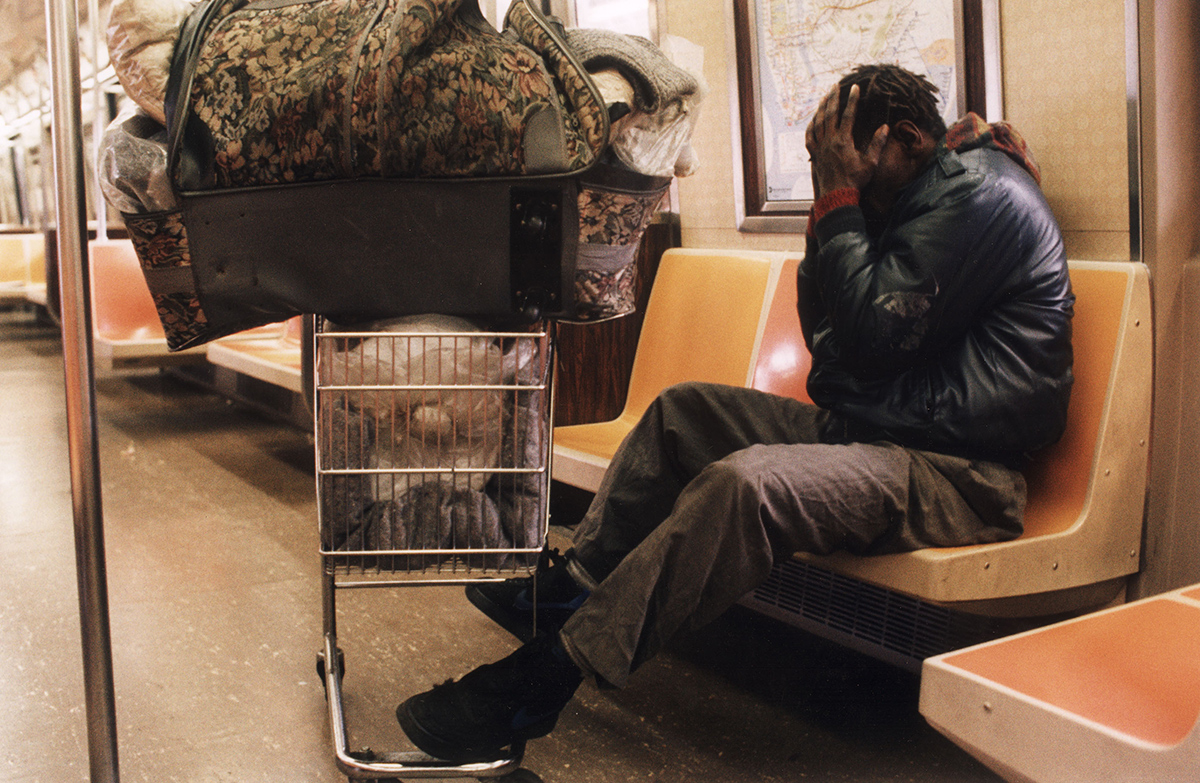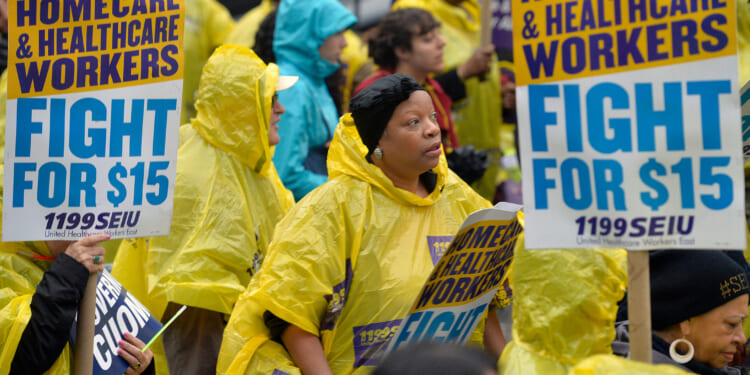Progressives have long sought to transform the United States into a Scandinavian-style social democracy. New York City offers a plausible demonstration of what that might look like—and it’s not an encouraging picture.
Advocates of building a social democracy in the U.S., such as sociologist Lane Kenworthy, argue that it can be constructed atop the foundation already laid by the New Deal and the Great Society. That’s precisely what New York already does. Its welfare state consists of the federal programs available nationwide, plus generous state and locally funded initiatives. New Yorkers qualify for food stamps and Supplemental Security Income—but also City Fighting Homelessness and Eviction Prevention Supplement (CityFHEPS) housing vouchers, Fair Fares transit subsidies, and homeless shelters on demand. New York State runs the nation’s most expensive Medicaid program; and Safety Net Assistance, a state cash-welfare initiative, supplements the federal TANF program. More than 2 million New York City residents live in rent-regulated housing.
Finally, a reason to check your email.
Sign up for our free newsletter today.
New York’s political conditions are friendly to social democracy, too. The Democratic Socialists of America are, at present, the most powerful political organization in the city. Boasting such high-profile members as Congresswoman Alexandria Ocasio-Cortez, the DSA exerts growing influence by threatening to run candidates in primaries against insufficiently left-wing Democrats and through its heralded ground game—on display in DSA member Zohran Mamdani’s decisive victory in the June 2025 Democratic mayoral primary.
Compared with the label “social democrat,” the Democratic Socialist brand is edgier and thus better suited to our strident times. Social democrats work within capitalism; Democratic Socialists aspire, somehow, to move beyond it. For now, what realistically lies within reach for the DSA and other New York progressives is an expanded local version of social democracy.
New York’s Scandinavia-on-the-Hudson model already costs billions annually in combined state and local spending. What does that money buy? The case for American social democracy rests on the claim that if government were more generous, we would enjoy stronger economic growth, a healthier middle class, and public spaces as clean and orderly as those of major European cities. New York delivers on none of these fronts. The city is still wealthy but grows slowly. Its middle class is fleeing. Public disorder remains chronic. Though New York continues to attract a disproportionate share of talent, the quality of its public services hardly justifies the cost of living. Progressives insist that there’s no reason America can’t be more like Sweden. They need to confront New York’s actual experience with big government.
Transit, housing, labor, and health-care benefits may be the social policies that best exemplify the social-democratic enterprise. In these areas, New York tries to deliver something that approaches progressive ambitions.
Start with public transportation. All social democracies pride themselves on the ideal of shared, universal transit. On Bloomberg’s Odd Lots podcast, Zohran Mamdani, discussing his vision of quality municipal services, spoke evocatively of a public service being “so excellent that even the wealthy use it.” Indeed, most New Yorkers commute by public transportation, compared with less than 5 percent nationwide. The subway system runs 24/7, and the lines stretch almost everywhere. Elsewhere in the United States, the only government alternative to a car is usually a bus system that performs erratically and runs along limited routes. Even at the standard flat rate of $2.90, or $132 for a monthly pass, the subway is an amazing deal for low-income New Yorkers, given the opportunity that it creates. And New York has lowered the price even more through Fair Fares, a $115 million program funded by city taxpayers and recently expanded to households making 145 percent of the federal poverty level. Mamdani, if elected mayor in 2025, has pledged to make New York’s bus system free. Routine fare evasion is already an indirect subsidy to antisocial New Yorkers, valued at over $600 million annually.
The city also spends heavily on housing. A 2019 Citizens Budget Commission analysis argued that, when transit and housing are taken as a package, New York ranks in the middle among major cities in terms of affordability. Still, housing affordability concerns run high. According to the New School’s Alex Schwartz, “New York City has persistently spent far more of its financial resources on affordable housing than any other municipality. . . . No other city government comes close to New York in its commitment to affordable housing programs.” Mayor Eric Adams’s administration’s capital budget for housing commits $25 billion over the next decade. In last year’s operating budget, New York spent over $1 billion on CityFHEPS, its local version of federal housing vouchers.
On top of the spending, New York regulates the housing market within an inch of its life. Over half of New York’s rental stock is public housing, or formally “stabilized,” or, for some reason, rented out below what would be justified on the open market. New York’s housing court must rank as one of the most pro-tenant in the nation, thanks to powerful eviction protections. These were recently strengthened in New York’s 2019 Housing Stability and Tenant Protection Act and 2024 Good Cause Eviction Act. New York was the first city in the nation to give all tenants a right to counsel in eviction proceedings.
Housing benefits in New York are not restricted to low-income residents. While it’s considered a virtue when affluent riders use the transit system, the same dynamic isn’t celebrated but is broadly tolerated in housing—an attitude that feels more European than American. When Andrew Cuomo proposed means-testing affordable housing during his 2025 mayoral campaign, he faced fierce backlash, probably because so many would stand to lose generous subsidies. Writing in the New York Post, Howard Husock noted that close to a third of tenants in rent-stabilized units earn six-figure incomes.
Homeless advocates often argue that housing investments will reduce street disorder and obviate the need for expensive shelter programs, thus helping to ease New York’s notorious homelessness problem. But notwithstanding New York’s all-hands-on-deck commitment to affordable housing, the city spends a few billion annually on homelessness, too—from shelter to prevention programs to supportive housing. The homeless population is 16.5 per 1,000, compared with 2.3 per 1,000 for the nation as a whole. New York grants a right to homeless shelter far more robust than any other U.S. city. Yet disorder in the streets and on subways remains a perennial source of public concern. During the first six months of 2025, New Yorkers filed 15,000 complaints with the city’s 311 public-services line about “homeless person assistance,” 21,000 about “encampment,” and 5,600 about “panhandling.”
The connection between housing and homeless services is characteristic of New York’s welfare system: new programs get launched to fix the flaws in old ones. Another example is universal pre-K and 3-K, the need for which would have been far less pressing were the Department of Education, which runs public K–12, more effective at its job. New York’s per-pupil expenditure on K–12 ranks as the highest among the largest 100 systems in the nation.

Labor policy is also a key part of the social-democratic model. New York City spends over half a billion dollars on job training annually. The region’s unionization rate (20 percent) is almost double the national average, the $16.50 minimum wage is more than double the national rate, and state and local versions of the Earned Income Tax Credit are in place.
Active labor-market policies were central to postwar Europe’s social democracies, designed to prevent extremism by sustaining employment and ensuring that generous welfare benefits did not erode the incentive to work. Planners aimed to make employment as attractive as possible—something socialist doctrine held that the private sector could not reliably achieve on its own. New York City has consistently failed to meet that standard. In every year since the early 1990s, the city’s unemployment rate has exceeded the nation’s, with the exception of the financial-crisis era and its attendant Wall Street bailouts. Its labor-force participation rate has trailed the nation’s in every year during that same span. The city’s “make work pay” policies have not forestalled rising public assistance rolls: 600,000 New Yorkers now receive cash welfare, an increase of more than 50 percent since Mayor Eric Adams took office in 2022.
Ninety-five percent of New Yorkers have health insurance, a rate only a few points off from European coverage norms. About half the city’s population is on Medicaid, the largest expense in the state government’s budget. New York State’s Medicaid program costs more than Florida’s and Texas’s combined. Not to be overlooked in the host of local benefits is the role of Safety Net Assistance, a state cash-welfare plan that enables federal welfare beneficiaries to keep receiving benefits after they’ve reached the federally mandated five-year cutoff.
Many European countries have long had powerful social-democratic parties. Scandinavia is so often held up as a model for such governance in part because of its political dominance throughout the twentieth century. From the 1930s through the 1970s, for example, the Swedish Social Democratic Party led coalition governments almost without interruption, under three prime ministers: Per Albin Hansson, Tage Erlander, and Olof Palme. Christopher Caldwell described that triumvirate’s reign as what would ensue “[i]f you had FDR, LBJ, and Ted Kennedy given half a century, unlimited resources, and zero opposition to build their own kind of socialism.”
New York City has never had a run of social-democratic rule quite like that; but retrenchment is rare, even under reform-minded mayors. Rudolph Giuliani, elected on a law-and-order and fiscal-discipline platform, oversaw a 5 percent increase in the city workforce and a 27 percent budget hike over two terms. Michael Bloomberg, who styled himself as a managerial reformer, presided over an 8 percent workforce expansion and a one-third jump in spending across three terms. Bill de Blasio, openly progressive, added another 8 percent workforce increase and a 20 percent budget rise in two terms. Eric Adams, despite running as a pragmatist, has pushed the budget to a record $115–$116 billion; the headcount is down 2 percent. The DSA agenda of the 2020s builds on city government’s historical tendency toward expansion.
How sustainable is this trend? Big government can be supported either by high social trust or by taxing the rich. When social-democratic systems in Scandinavia and elsewhere in Europe were built, trust levels were exceptionally high. Writes historian Tony Judt in Postwar, “in the aftermath of depression, occupation and civil war, the state—as an agent of welfare, security and fairness—was a vital source of community and social cohesion.” In the postwar era, trust was indispensable: social democracy asked citizens to hand over money to the state to provide goods and services that they might otherwise secure on their own.
Yet trust comes easiest to ethnically homogenous places, and New York is the opposite. Its foreign-born population is 37 percent, compared with 14 percent for the nation; more than 100 languages are supposedly spoken in Queens alone. If diverse America relies more heavily on taxing the wealthy to fund government than homogenous Scandinavia, New York’s dependence is especially acute. New York City’s 34,000 income-tax millionaires pay about 40 percent of the city’s personal income-tax bill, on top of their equally outsize contribution to the state budget, which funds numerous city social programs. New York still grows millionaires, but not at the rate it once did. Policy analyst E. J. McMahon has documented that New York’s share of American millionaires has been shrinking, meaning a loss of billions in city and state resources.
Some progressives suggest that New York–style social democracy benefits when the wealthy flee because fewer millionaires will be around to vote. Economically, however, the exodus is unsustainable. Scandinavian systems rely on steep marginal income-tax rates that reach further into the middle class than do American tax regimes, and they energetically deploy broad-based consumption taxes. Everyone receives benefits, but everyone pays. More recently, New York Democrats have focused on lowering middle-class taxes as part of a broader affordability agenda. In a city budget of $120 billion, general sales taxes contribute only $10 billion.
This imbalance is compounded by the ideological bent of New York’s Democratic Socialists, who treat social democracy not as an end in itself but as a step toward a postcapitalist future. That outlook encourages a more reckless version of social democracy, reinforced by the city’s heavy reliance on the wealthy. When public services underperform, the reflexive answer is more spending—always on the assumption that someone else will foot the bill.
Social democrats argue that their preferred model is inevitable in America because the essence of a modern welfare state is insurance—and the richer a society, the more insurance it demands. Wealth partly explains why American health-care costs run so high—Americans have more to spend—and why New York spends more than the national average.
But wealth is not the same as growth. Scandinavia’s economies remain recognizably capitalist—more capitalist than some understand. While no rival to Silicon Valley, they have produced a respectable roster of global firms—Volvo, Spotify, IKEA, Novo Nordisk. Swedes and Danes take pride in this dynamism and their culture of entrepreneurship. Social democracy itself reflects this evolution: born from socialist intellectual ferment in the nineteenth century, it aspired at first to replace capitalism. By the mid-twentieth century, it had largely made its peace with the market, recasting itself as an alternative to pure socialism.
By contrast, in New York, progressives are moving in a steadily more anticapitalist direction. In the past, New York City officials such as Michael Bloomberg’s economic chief Dan Doctoroff set out to build a city that radiated a sense of great things happening. Average New Yorkers might not live in Hudson Yards, the thinking went, but they could stroll its public spaces and marvel at its engineering feats. Since the Bill de Blasio years, however, progressives have tended to view New York’s real-estate and finance sectors as vaguely parasitic. DSA members sometimes praise “small business” but on a highly selective basis: witness Mamdani’s proposal to cut regulations for halal carts.
DSA leadership embraces economic mediocrity. The economy will be fine, they say; tax hikes will never wreck New York. But a decent economy is a far cry from an excellent one. This decade, the “gross city product” has grown at a notably lower annual rate (1.7 percent, on average) than the national gross domestic product (2.4 percent).
However much New York may resemble a social-democratic paradise in its concern for the neediest, its commitment to the second-neediest—the working and middle classes—is far less impressive. Policies designed to make life maximally easy for the very poorest often shift burdens onto those who work. The city’s persistent failure to manage street homelessness, addiction, untreated serious mental illness, and crime falls hardest on its transit-dependent working class—costs that the wealthy rarely encounter.
New York’s increasingly stringent tenant protections have narrowed a traditional path of immigrant advancement. For generations, newcomers without corporate jobs or 401(k)s built wealth by becoming small landlords. But annual evictions are down by about 50 percent since the early 2010s, a trend that tenant advocates cheer but landlords find much less encouraging. Immigrant associations have been some of the most vocal critics of New York’s pro-tenant legislation. The progressive push to make housing a “de-commodified” good, much like infrastructure or public safety, for low- and moderate-income households, will harm upward mobility in twenty-first-century New York.
Between 2012 and 2023, New York City experienced a net domestic out-migration of about 670,000 middle- and upper-middle-income households. New York is increasingly becoming a city of intergenerational poverty, on the one hand, and intergenerational wealth, on the other. New York explored the latter dynamic in a February 2025 cover article: “If you know someone under 50 who’s living like it’s the ’90s—who owns their apartment, who’s out every night, or who sends their kid to private nursery school and still has money left for vacation—it’s safe to assume there’s a baby-boomer behind them.” Manhattan Institute president Reihan Salam has suggested that resentment of this city-of-heirs dynamic helped Mamdani secure victory in this year’s Democratic primary. Yet even many of Mamdani’s ostensibly privileged supporters appear eager to exchange reliance on parents for reliance on government, which he pledges to expand.
In the Scandinavian vision, as former Swedish prime minister Stefan Löfven once told a New York University audience, “the welfare system must work as a trampoline.” That’s not an image evoked by the South Bronx, with its chronic stasis and city-leading rates of social-program use. A mid-2010s study by the New York comptroller’s office found that about one-fifth of homeless families were headed by an adult who, as a child, had spent some time in a city shelter. Harvard economist Raj Chetty, the leading scholar of U.S. mobility, has ranked regions for their success in facilitating intergenerational advancement. In one recent study that he led of the top 50 metros, New York ranked in the middle, one of those urban areas now seeing more downward than upward mobility. New York’s record on poverty alleviation is mediocre, despite no lack of awareness of the problem (it’s the media capital), an extensive philanthropic sector that adds private to already-great public resources, and a strong concentration of clinical and other professionals that other U.S. communities could only dream of enjoying.
The assumption that ever-larger health and human services will naturally yield a better social order—because Scandinavia looks pleasant—is a shaky proposition, at best. If Europe has less vagrancy because it is more generous, why does New York suffer far more of it than the American cities that it vastly outspends?
New York is the land where the Great Society never died. No social problem is thought too daunting for government to solve, given sufficient will and resources. Ronald Reagan challenged the notion that government’s natural tendency is expansion. In New York, that belief endures.
Top Photo: The New York region’s unionization rate (20 percent) is almost double the national average. (Wang Lei/Xinhua/Alamy Live News)
Source link















